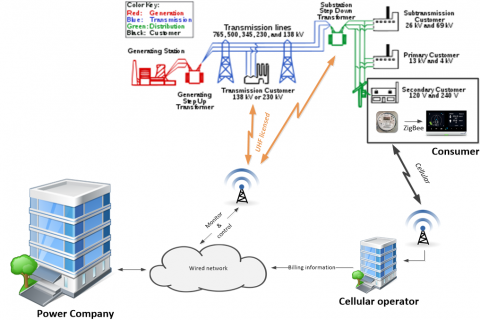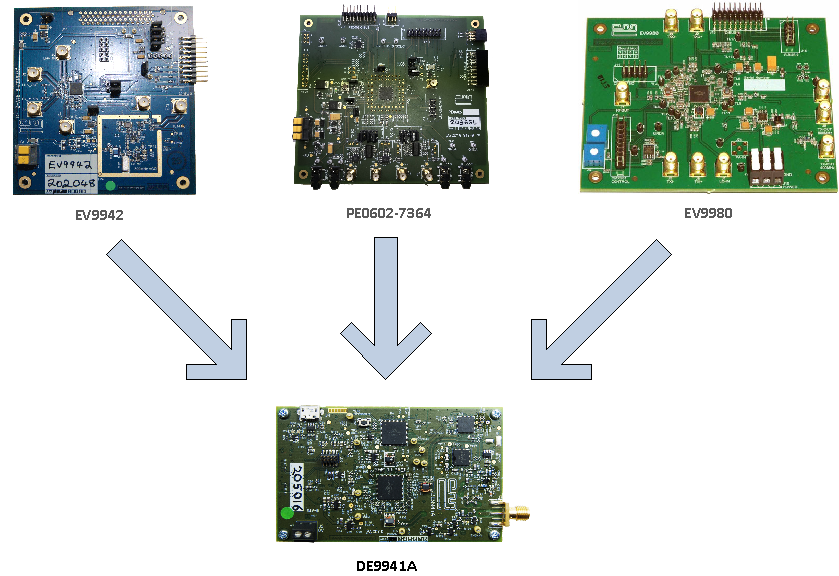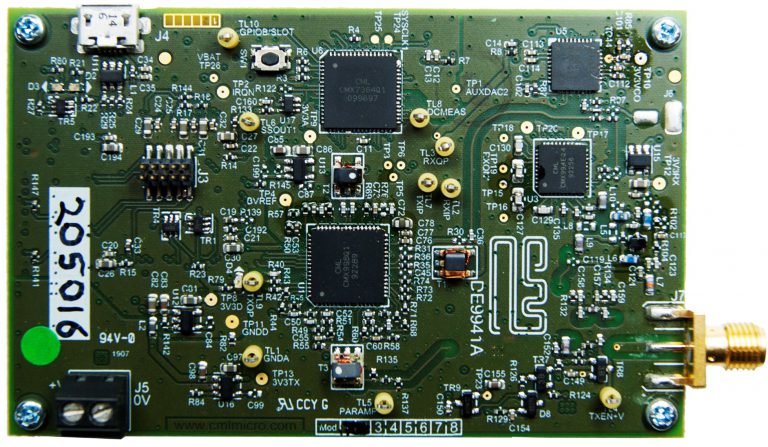Industrial IIoT has unique requirements which make selection of suitable communications technologies more of a challenge than in applications such as Smart Cities where IoT is used to monitor free parking spaces or the control and monitoring of street lamps. In industries such as Utilities wireless systems have been used for many years and a mixture of technologies are applied, each suited to a particular set of application needs.
Let’s look at two applications in the electricity supply sector and compare and contrast their requirements.

Figure 1 Typical electricity network
The picture above shows two wireless networks, firstly the electricity supply network providing power to the home or factory and then secondly the metering network reporting consumption back to the provider for billing purposes.
In the metering network it is not uncommon to find short range solutions such as ZigBee coupled with wide area cellular M2M (machine to machine) to provide backhaul to the utilities’ metering infrastructure. ZigBee provides a low power short-range link from the meter (which is often remotely located in the property) to the consumer’s consumption display unit. This needs a solution that is low cost, as the number of meters deployed can be tens to hundreds of thousands and it is the utility company that bears this cost. Unlicensed radio technologies such as ZigBee are more susceptible to interference as they share radio frequency bands with others but in this case the wireless link does not need to operate in real time or be highly reliable (information on the display unit is only updated every few seconds and a missed update is unlikely to be noticed).
As ZigBee has only a short range it is necessary to forward the meter data using a second wireless technology and here cellular systems are a common choice, particularly in built up areas that have good radio coverage. These networks are already geared to supporting a very high density of users and so fit well with the requirement to handle many meters in urban locations. Cellular M2M modems are also low cost and by using the shared cellular network the utility company saves the cost of deploying their own dedicated network. Again, this link is not time critical.
On the other hand the electricity supply infrastructure has different requirements: to maintain a stable supply, real time control is required with guaranteed resilience and communications latency. Frequently this is part of the utility operator’s terms of service or a legally mandated requirement. On the transmission side the density of wireless nodes is far less and nodes may be read over a wide geographic area, including out-of-range of cellular infrastructure. Links also need to be secure, which in many cases is heighted by the use of proprietary protocols as well as standardized data encryption methods. This calls for a different kind of wireless link and frequently this is served by dedicated licensed links. These links are usually at lower frequencies (typically UHF) which in turn supports longer range and by using a licensed frequency the utility company ring fences the link from unwanted interference and provides resilience in the network. Also having a dedicated licensed link lowers the potential for interfering transmissions and so the link properties are more predictable and latencies are known and repeatable (in the UK 10mS end-to-end latency is required for the sensors and actuators used in the power industry’s high voltage protection circuits). Finally the licensed link can use proprietary protocols and by using higher RF powers, makes them less susceptible to jamming.
A typical example is that of a pole-mounted ACR (automated circuit recloser) that requires monitoring and control. Pole-mounted reclosers are common around the world, especially out of urban environments and are essentially high voltage rated circuit breakers with integrated current and voltage sensors and a protection relay, optimized for use as an overhead network distribution protection asset. In the case of Smart Grids these assets are effectively computer-controlled switchgear which can be remotely operated and interrogated, usually via a radio link.
When engineers want to develop such systems they invariably look to bread board and test solutions. In the case of ZigBee there are numerous suppliers that offer readily available demonstration boards; similarly in the case of cellular solutions M2M modules are available from numerous suppliers but when it comes to licensed wireless data modems the situation is somewhat different.
Because the size of the market for these products is considerably smaller, generally there are no off-the-shelf solutions. The modem designs require higher RF performance and as a consequence tend to be less integrated having separate RF and baseband sections. So when an engineer comes to look at bread boarding such a modem this becomes a more difficult challenge requiring the interconnection of a number of individual evaluation boards. This has its own issues, getting interfaces to match between boards, having a common control bus between boards and the potential for unwanted RF interactions unless boards and cables are adequately shielded.
CML Microcircuits has been a long term supplier of semiconductor solutions into these markets and offers a range of IC solutions supported by single device-specific RF and baseband evaluation boards suitable for bread boarding such systems. Having recognised the issues faced by developers CML has looked to address these issues and make the developer’s task less daunting. As well as offering individual evaluation boards the company has released a single board software defined radio solution for industrial IoT applications that combines all aspects of a UHF transceiver including an on-board ARM M4 host controller.
Figure 3 Reducing the complexity to a single credit card sized PCB
Its software defined architecture allows support of multiple channel bandwidths (12.5/25/50kHz to be used whilst the integrated circuits used support operation from 100MHz to 1GHz although the design is optimized for operation in the 350-400MHz band.
The board can be used to demonstrate receive and transmit performance with multi-level QAM, FSK and GMSK modulation types. These support legacy modulations already widely used across utility industries as well as higher efficiency linear modulations that provide better spectral efficiency in narrowband radio channels. The modem’s RF performance is compliant with EN 302 561 / EN 300 113 where applicable.
Using the DE9941A board developers can quickly configure test systems and evaluate performance under real life operating conditions. Its small size also allows it to be used in mobile network testing, something previously difficult to accomplish using individual boards lashed together.
Now developers have an array of easy to use single board evaluation solutions for Industrial IoT covering a range of licensed and unlicensed technologies, allow faster system development and more comprehensive performance evaluation.
Figure 4 DE9941A SDR Demonstrator for Industrial IoT modem applications






